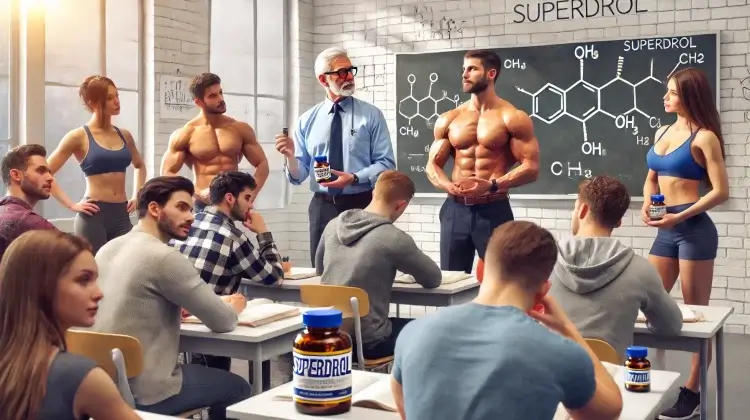
Estimated reading time: 6 minutes
Table of contents
Introduction
Methasterone (17β-hydroxy-2α,17α-dimethyl-5α-androstane-3-one; 2α,17α-dimethyl-etioallocholan-3-one, 17β-ol; Methyldrostanolone; Superdrol), a member of the 5α-androstan-3-one class of anabolic-androgenic steroids (AAS), nonaromatizable and non-5α-reducible (since it’s already 5α-reduced), and a designer steroid, meaning that it has been [although it has since been variously banned by different governments] resurrected by dietary supplement companies and marketed as a prohormone using legal chicanery. Methasterone is not fairly classifiable as a prohormone since it does not serve primarily as a prodrug to a more potent androgen metabolite, although its primary metabolite dihydromethasterone (2α,17α-dimethyl-5α-androstane-3α,17β-diol) is undoubtedly anabolic active, its lack of a 3-keto group, whose lone pair of electrons serve as an electron acceptor for the androgen receptor’s N-terminus/amino-group, after extensive hydroxylation, is less potent than methasterone itself. [1]. [2].1. However, methasterone’s most noteworthy feature is that it is potently hepatotoxic (liver-damaging). [3][5].
Methasterone is an AAS with awesome absolute anabolic potency versus its markedly reduced androgenic potency. [4].

However, methasterone poses profound risks for hepatic injury including cholestasis and jaundice. [5]. Hepatic injury may present with rapid onset in many instances. This fact connotes that rational methasterone use requires a most careful balancing of considerations (trading-off) of its most potent muscle anabolism against this hepatotoxic risk. Since its putative benefits are most advantageous deep into prep, its use then is rational at a very high level for those in pre-contest dieting for an event that could provide a valuable return on investment.
Superdrol is widely regarded, first, as particularly intolerable; as well as for maintaining a “full,” “3-D” look deep into prep when energy and carbohydrate tend to be low. It’s regarded as outstandingly strength boosting, and is reputed as well to most potently reduce blood glucose in a manner associated with insulin sensitizing effects. Yet, the hard data [that is unduly thin for methasterone and even for its clinical counterpart dimethazine] does not support these aspects of its effects.
2α,17α-dimethyl-5α-3-oxo
The 2α,17α-dimethyl– shape of the methasterone steroid gives it a structure that is doubly potent since the 2α-methyl group enhances oral absorption and/or prevents the rapid inactivation of the steroid by tissue enzymes, independently of the same function of 17α-methylation, as evidenced by, e.g., drostanolone’s oral activity, whose rat anabolic activity is equivalent to 17α-methyltestosterone (MT; methyltestosterone) but with very low androgenic activity. [8]. These two features combine to yield a most potently muscle anabolic and antiestrogenic drug with low androgenic potency, albeit with pronounced hepatotoxicity. [8].
Muscle Anabolism
Methasterone’s distinction from drostanolone (Masteron) by its 17α- alkylation2 changes its three-dimensional conformational shape and electrochemical properties so that its α-face (think back-side) more potently activates the AR. [4]. The dissociation between methasterone’s anabolic versus androgenic potency is impressive: In the early days of research into the mechanisms of androgens, Zaffaroni (1960) showed that 2α-methylation ↑anabolic and markedly ↓androgenic activity to the tune of its having 20% of the androgenic and 400% of the anabolic activity of methyltestosterone when ingested but unlike drostanolone (Masteron) the 17α-methyl attachment confers tremendous hepatotoxicity in line with its additional anabolic “boost.” [8]. Despite this dichotomy between anabolic and androgenic potency, methasterone cannot fairly be regarded as an attenuated androgen (e.g., oxandrolone, danazol, stanozolol, appropriate for female and child use) because of its absolute potency – even at impracticably low doses, it’s still markedly androgenic in absolute terms.
Hepatotoxicity
Methasterone’s potent hepatotoxicity may fairly be summed up by the observation that one-sixth (⅙) of the parent steroid remains unmetabolized, reflecting considerable hepatic strain. [3]. Additionally, methasterone has been shown to inhibit 3-oxo-5β-steroid-Δ4-dehydrogenase (AKR1D1) that serves in normal metabolism to introduce the cis ring A/B conformation and to clear steroids, causing hepatic cholestasis. [9].
This author would characterize methasterone’s hepatotoxicity as so exceptionally risky that its use for intermediate bodybuilders is anathema to reason.
Conclusion
Despite the dearth of data regarding biologic or physiologic effect (PE) with respect to effects like purported insulin sensitivity or fullness despite carbohydrate depletion, analysis by chemical structure (CS) reveals the basis for Superdrol’s remarkable anabolic potency and hepatotoxicity. Superdrol’s unique 2α,17α-dimethyl structure gives it an almost outlandish potency such that even without the 17α-methyl group, Masteron can serve [albeit weakly] as an attenuated androgen via oral ingestion. Its inhibitory effects on AKR1D1 provide additional answers to why it is so hepatotoxic. The rational use cases of Superdrol are strikingly limited, arguably best relegated to deep into contest prep for a very advanced bodybuilder reasonably vying for a pro card, or to at least win an important show in weeks.
References
[3] Zhang J, Lu J, Wu Y, et al. New Potential Biomarker for Methasterone Misuse in Human Urine by Liquid Chromatography Quadrupole Time of Flight Mass Spectrometry. Int J Mol Sci. 2016;17(10):1628. Published 2016 Sep 24. doi:10.3390/ijms17101628
[4] Vida, Julius A. Androgens and Anabolic Agents. Academic Press, 1969.
[5] Tran BN, Okoniewski R, Spink BC, LeMaster DM, Aldous KM, Spink DC. Androgenic steroids in Over-the-Counter dietary Supplements: Analysis for association with adverse health effects. Steroids. 2023;193:109199. doi:10.1016/j.steroids.2023.109199
[6] Berloco n, Masserini c. L’impiego della dimetazina in terapia antitubercolare [the use of dimethazine in antitubercular therapy]. G Ital Chemioter. 1963;10:32-35.
[7] Mastrorilli A. Gli steroidi anabolizzanti di sintesi (dimetazina) nella osteoporosi [Synthetic anabolic steroids (dimethazine) in osteoporosis]. Minerva Ortop. 1966;17(7):399-401
[8] Zaffaroni, A. The effect of alkyl- and electronegative group substitution on steroidal hormone activity. Acta Endocrinol Suppl (Copenh). 1960;34(Suppl 50):139-45. doi: 10.1530/acta.0.xxxivs139
[9] Kędzierski J, Allard JA, Odermatt A, Smieško M. Assessment of the inhibitory potential of anabolic steroids towards human AKR1D1 by computational methods and in vitro evaluation. Toxicol Lett. 2023 Aug 1;384:1-13. doi: 10.1016/j.toxlet.2023.07.006
1Supplementary data: compressed archive of modeling from SWISS suite available by request.
2And [distinguished] from dimethazine (DMZ; Dostalon®; Roxilon®) by its lack of its being coupled to yet another methasterone molecule by azine-linkage, an outlandishly potent AAS that has remarkably been used in medicine to treat conditions that range from tuberculosis to cachexia and osteoporosis. [6]. [7]. In 2008 dimethazine was released as a “dietary supplement” sold over the internet by iForce Nutrition, under the name Dymethazine.
About the author
Type-IIx is a physique coach, author, and researcher. Bolus: A Practical Guide and Reference for recombinant Human Growth Hormone Use will be his first published textbook, anticipated for release in early 2023. Ampouletude.com will be Type-IIx's base of operations for coaching services and publications. Type-IIx is proud to be a contributing writer to MesoRx, his home forum, where he is a regular poster.

Leave a Reply
You must be logged in to post a comment.